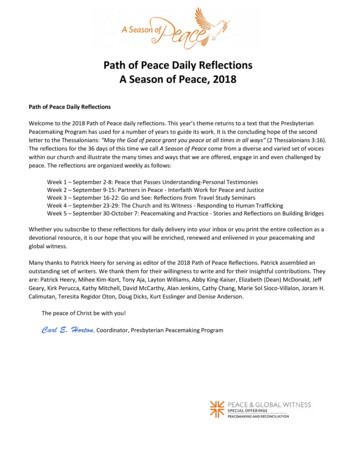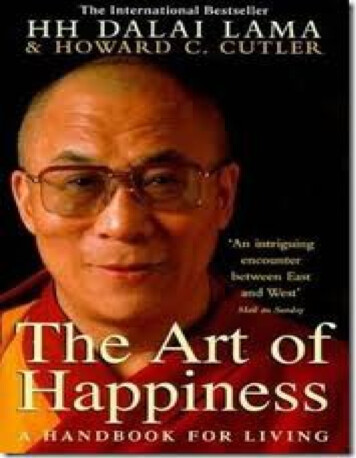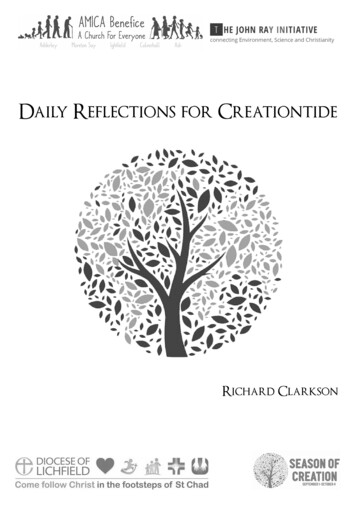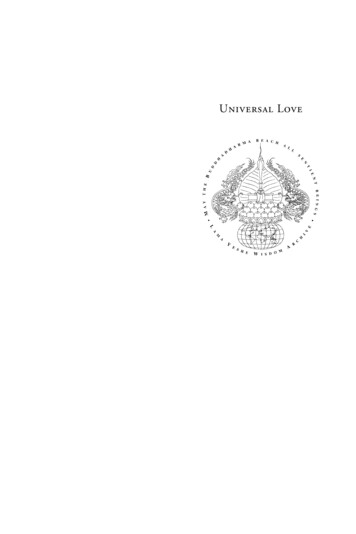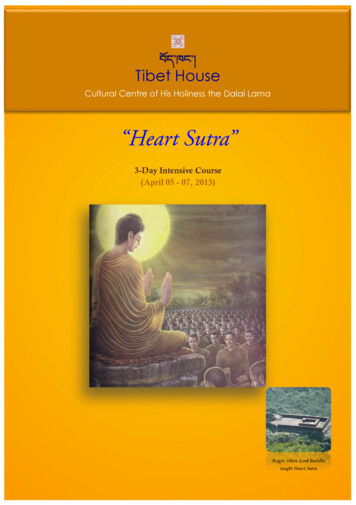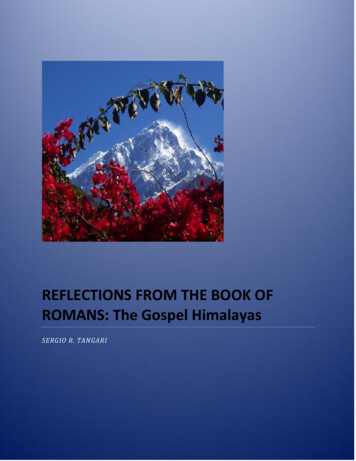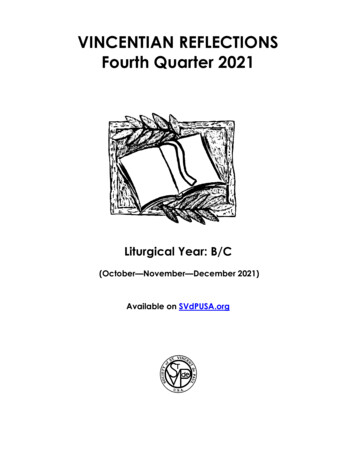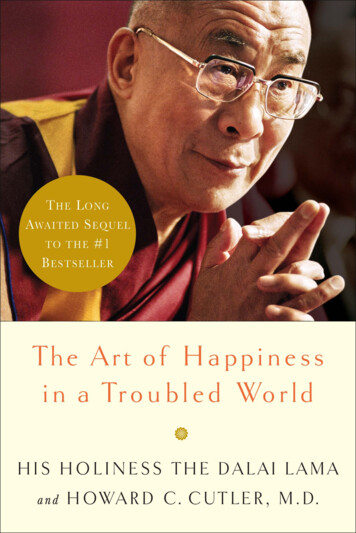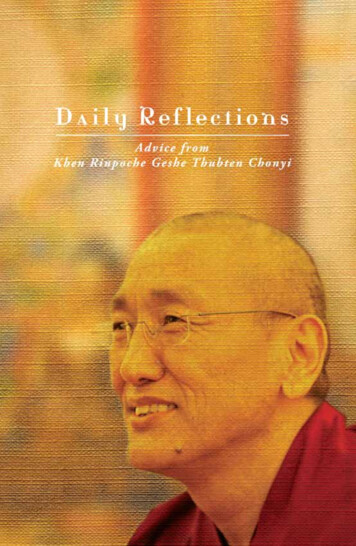
Transcription
Published for free distributionDaily ReflectionsAdvice from Khen rinpocheGeshe thubten ChonyiAmitabha Buddhist Centre44 Lorong 25A, GeylangSingapore 388244Tel: 6745 8547 Fax: 6741 0438Email: centre@fpmtabc.orgWebsite: www.fpmtabc.orgNovember 2007 – 2000 copiesMay 2008 – 1000 copiesNovenber 2011 – 5000 copies Khen Rinpoche Geshe Thubten Chonyi, 2007All rights reservedFree DistributionNo part of this work may be reproduced in any form or by any means, electronicor mechanical, including photocopying, recording, or by any information storageand retrieval system or technologies now known or later developed, without writtenpermission from Khen Rinpoche Geshe Thubten Chonyi.Designed by Kennedy Koh12
CONTENTSINTRODUCTIONiIntroduction 4iiBiography 81What is Dharma? 9The Basic Program is a five year study program launched atAmitabha Buddhist Centre (ABC), an affiliate of the FPMT1, inAugust 2003 at the request of its spiritual director, Lama ZopaRinpoche.2Studying the Dharma 193Need for reflection and analysis374Overcoming negative thoughts475Practising pure perception606Faith 657Advice on practice 718Precious human rebirth889Death and impermanence9310Overcoming attachment to the body9511Joyous effort 9812Subduing anger 10313Generating bodhicitta 11314Wisdom realising emptiness125This program, contrary to its name, was intended for seriousstudents who were prepared to commit themselves to thisdemanding course. It is “basic” insofar as the syllabus has beenconceived by Rinpoche to ensure that senior students, at thevery least, have studied these essential texts he had personallyselected.ABC was able to launch this program because of the arrival on25th October 1999 of its new resident teacher, Khen RinpocheGeshe Thubten Chonyi. Small in stature, humble in demeanour,Khen Rinpoche’s appearance gave very little sign of hisformidable scholastic reputation at Sera Je Monastic University,where he studied from the age of 18, until he emerged as thefirst Lharampa Geshe from Kopan Monastery (FPMT’s mothermonastery in Nepal). Rinpoche said Khen Rinpoche was reputedat Sera Je as being someone who “has known” the Dharma, iswidely respected for his exemplary behaviour and conduct andwhose knowledge is like the mountain.It should be noted that, at the present moment, there are only38 geshes serving as resident teachers in the family of over 150FMPT centres around the world. Rinpoche recently commentedon the good fortune of the FPMT to have such excellentteachers:“.who are not just scholars in words, but beings who are actually livingthe practice. Sincere hearted, good hearted, this is an extremely important3ContentsIntroduction4
quality for teachers, a very good model for students, for their inspiration fortheir studies, inspiration to have deep, clear understanding of Dharma, andbe inspired to practice. And that’s the most important thing, without aqualified teacher then nothing happens, nothing is able to be developed.”2ABC is therefore very, very fortunate indeed to be under the careand guidance of an exceptionally well-qualified teacher. Over theyears, Khen Rinpoche has become father and mother, counselor,confidante, mentor, coach and the most perfect of spiritualguides and virtuous friends to countless ABC students as well asto many other devotees who come to consult him.This book then is a compilation of Khen Rinpoche’s openingremarks and motivations at the beginning of lessons offered inModules 5 – 9 of the Basic Program3 to commemorate the eighthanniversary of Khen Rinpoche’s arrival in Singapore.These teachings offer valuable advice related to our Dharmastudies and practice: how to check whether our practices areDharma, the need for study and constant reflection on theBuddha’s teachings, and how to overcome our afflictions andproblems so that we can truly benefit others.In Singapore, we all lead very busy and stressful lives, jugglingpersonal, family and work commitments and it can be hard tomake time to attend Dharma teachings. There is much foodfor thought contained in this compilation. So wherever youare - commuting on public transport, waiting for a friend at anappointment, between meetings – pull out this book and take alittle sip of the Dharma.We would like to take this opportunity to thank Ven. TenzinGyurme, who is our Basic Program translator, Cindy Chengwho first prompted her husband, Phuah Soon Ek, to transcribe5Introductionthe Basic Program teachings, Fiona O’Shaughnessy who spearheaded the editing of the transcripts, Yap Siew Kee, Tara Hasnainand Cecilia Tsong who helped with proof-reading and the teamof transcribers led by Phuah – Vivien Ng, Angie Xiao, Tok SockLing, Cheng Tien Yit and Alison Wong. The transcripts werefurther prepared for this compilation by Cecilia Tsong. We wouldalso like to thank Lim Cheng Cheng and Tara Hasnain for theirinvaluable input and editorial suggestions.May whatever merit is generated by publishing this book bededicated to the long life and good health of our preciousteachers, especially His Holiness the Dalai Lama, Lama ZopaRinpoche and Khen Rinpoche Geshe Thubten Chonyi as wellas to the immediate fulfilment of all their holy wishes. May theBuddha’s teachings, especially the stainless teachings of LamaTsong Khapa, flourish in the ten directions, and may AmitabhaBuddhist Centre be free of all obstacles in spreading the holyBuddhadharma in Singapore exactly according to the wishes ofLama Zopa Rinpoche.The Editorial Team / SingaporeOctober 2007Updated 2011FPMT stands for the Foundation for the Preservation of the MahayanaTradition. To find out more, go to www.fpmt.org2An excerpt from a talk given by Lama Zopa Rinpoche before and after GuruPuja at Tse Chen Ling, San Francisco, USA on 26th April 2007.3Modules 5 - 9 were conducted from 12th August 2005 to 11th October2007. Modules 5, 7, 8 and 9 covered Chapters 1-9 of Shantideva’s “Engagingin the Bodhisattva Deeds” while Module 6 was a commentary on the lojong(mind transformation) text, “The Wheel-Weapon.” The audio recordings andedited transcripts of these modules can be found on the ABC website, www.fpmtabc.org.1Introduction6
BiographyKhen Rinpoche Geshe Chonyi has been the resident teacher of AmitabhaBuddhist Centre since October 1999. He was born in Nepal in 1962 andwas ordained by Kyabje Lama Zopa Rinpoche in 1974 at the age of twelve.Khen Rinpoche holds a Geshe Lharampa degree, which is the highestTibetan Buddhist doctorate awarded to monks from Sera Je MonasticUniversity. This degree requires at least 20 years of intensive study anddebate and only the most outstanding students qualify to sit for the exams.After graduating as a Geshe in 1997, Khen Rinpoche joined the prestigiousGyurme Tantric College for a year to further his studies on tantricBuddhism. He was awarded first position in his group for the highestTantric Ngarampa (Master of Tantra) degree. He then returned to KopanMonastery where he taught Buddhist philosophy.With the support of Lama Zopa Rinpoche and the late Khensur RinpocheLama Lhundrup (then abbot of Kopan Monastery), Khen Rinpochestarted teaching the five-year Basic Program at ABC in August 2003.This first cycle of the Basic Program was completed in September 2009with over 25 students graduating from this cohort.Khen Rinpoche was then requested and kindly agreed to teach anothercycle of the Basic Program for new students at ABC. The second cycle ofthe Basic Program began in June 2011.In July 2011, Khen Rinpoche was appointed abbot of Kopan Monastery,in addition to his duties as the centre’s resident teacher.Besides being perfectly qualified to teach such a study program, KhenRinpoche is also renowned for his ability in developing the students’analytical skills through discussions, debate and written assignments.Khen Rinpoche is held in great esteem for his illustrious conduct, vastlearning and great kindness, wisdom and compassion.7BiographyBiography8
Chapter 1What is Dharma?What is more important - the happiness of this lifeor future lives?“What am I looking for - the happiness of this life alone or thehappiness of my future lives?” This is a very important questionthat we must ask ourselves every day. When we are more concernedwith the happiness of this life, whatever Dharma practices weengage in become impure because the mind is controlled by thethree mental poisons of anger, attachment and ignorance.If we are more concerned about our future happiness, then wehave to think: “What can I do now that will definitely benefit mein my future lives?”If we are honest with ourselves, we will find that instinctively,we are looking for the happiness of this life alone. As this is ourmain motivation for everything we do - whether we are recitingour daily prayers, listening to teachings, receiving initiationsor consulting our gurus - all our actions are motivated by theafflictions and are only expressions of our desire to achieve thehappiness of this life.Because of this attitude, the Dharma practices we engage in maylook like Dharma but in reality do not become Dharma and theywill not benefit us in our future lives.9What is Dharma?We need to shift our emphasis from focussing on the happinessof this life alone to placing greater importance on the happinessof our future lives. As Buddhists, we should accept the law ofkarma. Consider our lifespan. Maybe we can live till we are 60years old, but compared to the duration of our future lives,we have to take rebirths for many eons to come. Based on thiscomparison alone, the happiness of our future lives is clearly farmore important.Whether we end up with good or bad rebirths depends on whatwe do in this life. If we end up with bad rebirths in our futurelives, we will have to suffer for eons. Compared to the sufferingwe will have to endure then, this life’s suffering no longer seemsso unbearable. Happiness in our future lives is definite, providedwe create the causes now.When our goal is the happiness of our future lives, then ouractions will all become Dharma. Once they become Dharma,these activities will definitely benefit us in our future lives.Therefore, it is very important that we consider this very carefully:“Am I doing this for this life or for my future lives?” Whateverour answer may be, we then have to ask, “Why am I doing thisfor this life/my future lives? Which is more important - this lifeor my future lives?”We should have the confident attitude: “What I am looking for isthe happiness of my future lives.” What is the benefit of havingthis attitude? Because we place more importance on our futurehappiness, the three mental poisons will naturally weaken andwe will experience more mental peace and happiness. Otherwise,when our motivation is focussed on the happiness of this lifealone, the afflictions only become stronger, leading to moreunhappiness, problems and suffering.What is Dharma?10
From my side, it is my responsibility to tell you this. But whetherthis advice benefits you depends on you. Just listening to theadvice does not help. You need to think about it, not just oncebut every day until you have some feeling or experience in yourheart.at cultivating the causes for such a rebirth, this means avoidingnegative actions and engaging positive actions. Such behaviourwill naturally bring us fewer problems in our daily lives.What is Dharma practice?The purpose of the BuddhadharmaThere are only two goals for studying and practising theBuddhadharma - either the temporal goal of higher rebirth orthe ultimate goal of liberation and full enlightenment.There are no other reasons for studying and practising theDharma. It is not for improving one’s business, removing healthobstacles or solving other worldly problems. The main reason iseither to achieve a good rebirth or ultimate happiness, since wewant happiness and not suffering. Obviously we also want the bestform of happiness, which is liberation and full enlightenment.It is so important to remember this and to remind and askourselves all the time, “Why am I engaging in these studies andpractices?” We should not be mistaken and confused aboutour goal. When people come to the Buddhadharma with theexpectation that it will solve their worldly problems and things donot turn out according to their wishes, they become disappointedand lose faith in the Buddhadharma, abandoning and criticisingthe teachings. This happens because of the lack of clarity aboutwhat one is working for, and being too short-sighted with regardsto what one wants to achieve.Working for a good rebirth as a human being or a god is a biggergoal than just being concerned about this life. When we work11What is Dharma?This is very important - we must ensure that whatever practice wedo becomes Dharma practice. Often, we seem to be practisingDharma, but most of the time, that practice does not actuallybecome Dharma.There is a historical account of a conversation betweenDromtoenpa - Lama Atisha’s heart disciple - and a practitioner.One day, Dromtoenpa saw this practitioner circumambulating astupa and he said to him, “It is good that you are circumambulatingthe stupa, but would it not be better for you to practise theDharma?”Upon hearing this, this practitioner thought that he should dosomething else. So, the next time Dromtoenpa saw him, hewas reciting a sutra. Dromtoenpa said, “It is good that you arereciting this sutra, but would it not be better for you to practisethe Dharma?’This practitioner then thought that maybe Dromtoenpa wasreferring to meditation. He decided to go to his room and beganto meditate. When Dromtoenpa saw this, he said to him, “It isgood that you are meditating, but would it not be better for youto practise the Dharma?”This practitioner was now thoroughly confused. He could notthink of any other Dharma practices to do, so he went toWhat is Dharma?12
Dromtoenpa and asked him, “What should I do? What is Dharmapractice?” Dromtoenpa replied, “You have to give up this life.”What is the significance of Dromtoenpa’s reply?1. It shows that Dharma practice is primarily done with themind and not with the body or speech.2. It shows that, in order to practise the Dharma, we have togive up our preoccupation with the happiness of this life,i.e., giving up the eight worldly dharmas because failing todo so means that our actions may look like Dharma but arenot Dharma.How do we give up our preoccupation with the happiness ofthis life? We have to reflect on how this human life of leisureand opportunity that we have is finite and will not last forever.Death will come. By reflecting on this repeatedly, we will be ableto reverse the attraction to the preoccupations of this life.Lessons from Lama YesheI was twelve years old when I went to Kopan monastery. LamaThubten Yeshe was still alive then and he taught us by making usmemorise questions and answers he had written and pasted onthe wall.There were many questions but one I can still remember was,“Why do we need to practise the Dharma?” The questions were inTibetan, and at that time, I was more familiar with my nativedialect, Sherpa. Still, I memorised the question even though Idid not understand its meaning. The answer was: “We all desirehappiness and do not want suffering. The only way to abandon all suffering isthe practice of the Dharma. Therefore, we have to practise the Dharma.”13What is Dharma?Another question was, “Just beating the drum, ringing the bell andperforming the rituals – are these actions Dharma?” The answer to thatwas, “Beating the drum, ringing the bell and reciting mantras alone are notnecessarily Dharma. Why? Because you can also teach animals to do thesethings.”At that age, the young monks were all preoccupied with gamesand playing, but since we had to pass our examinations andmemorisation tests, we had to memorise the questions and theiranswers even though we did not fully understand their content.I am telling you this story to emphasise that Dharma practiceis performed primarily with our minds and not our bodies orspeech. Reciting mantras, doing our daily commitments andprayers, knowing how to do some rituals - these things are notnecessarily Dharma.Practising the Dharma means improving our minds andweakening our afflictions, the nature of which is to disturb ourminds, leading to suffering and unhappiness. Until the afflictionsare eliminated, we will continue to experience problems anddifficulties. The Dharma is the only way to eliminate afflictions.The distinction between Dharma and non-DharmaThe way to make our practice Dharma is to reflect on Lam Rimtopics such as the difficulty of obtaining a precious human rebirthand the nine-point meditation on death. These contemplationswill gradually weaken our attachment to this life and also help usset a larger, more far-sighted goal. Gradually, all our actions willbecome Dharma.What is Dharma?14
Dromtoenpa was once asked, “What separates Dharma from nonDharma?” His answer: “When the activity you are engaged in becomes anantidote to your negative emotions and afflictions, that activity is Dharma.When your activities are not an antidote to your afflictions, then it is notDharma.”We need to remember and reflect on these special instructionsof the great Kadampa masters, especially the advice on thedistinction between what is Dharma and what is non-Dharma.Whatever we do in our daily lives – our daily commitments,coming to class to listen to teachings and so forth – we mustcheck to see whether these activities are Dharma or not.If we find that we have been practising for years but are notgetting anywhere, it is because our practice has not been Dharma.They have not been antidotes to our afflictions and the result isthat we are stuck and unable to make any progress.Beginning to overcome our afflictionsThe advice of the great Kadampa masters, especially the advicepertaining to the differentiation between what is real Dharmapractice and what is not Dharma, is extremely important. In anutshell, Dharma is any action that is an antidote to our negativeemotions. You must keep this in mind.From the moment you consider yourself to be a Dharmapractitioner, you should always relate the teachings to the state ofyour mind and check if you are working to defeat your afflictions.Whatever you do – be it listening to the teachings, doing yourdaily commitments, practising generosity and so forth - youshould check: “Will doing this help to weaken or even destroy15What is Dharma?my negative emotions?” and set the motivation, “I am doingthis so that I can subdue my afflictions.” By sincerely settingsuch a motivation, the process of destroying our afflictions hasalready begun. Overcoming our negative emotions does nothappen overnight. Although the realisation of emptiness is thedirect antidote to them, we can start fighting them now with ourdetermination and motivation.When you listen to the teachings and find the advice useful orinspiring, try to put it into practice. Even if you are unable toapply the advice immediately, at the very least, think, “May I beable to do so in the very near future.”Integrating the Dharma with our mindsGyalsab Je’s message is: “If you are someone who seeks liberation orenlightenment, you need to exert joyous effort especially when you have thishuman life of leisure and endowments; your faculties are complete; youare free of obstacles to your Dharma practice and you have the necessaryconditions for your spiritual development. Having found this opportunity,you should not waste it but use it to engage in something beneficial for yourfuture lives.”Our problem is that we do not integrate the Dharma with ourminds. For example, we have heard countless teachings on theprecious human rebirth but our minds remain unmoved. Insteadof reflecting on the topic, we feel bored, thinking “I have heardthis so many times.” There is no feeling for and little interestin this subject. We should not allow ourselves to end up in thisstate.What is Dharma?16
It is important that we do not simply look like a practitioner fromthe outside – doing our commitments, prayers and practices– but feeling empty inside. If our minds don’t change, we willencounter many problems and much suffering at the time ofdeath. It would be ridiculous if we finally ended up in the lowerrealms.It is important to generate a pure and correct motivation forattending these classes. We should always remind ourselves whywe are here, that we are here to learn how to improve our minds.The purpose of studying the Dharma is not to use it to checkthe minds and actions of others. Using the Dharma against otherpeople is a mistake. That is not why we study the Dharma.Therefore, whatever Dharma we engage in, make sure it becomesDharma. Whatever virtuous actions we do, make sure they arevirtue. We should check our minds all the time.Transforming our minds for the betterThe Kadampa masters said: “The purpose of all the Buddha’steachings, the great treatises and commentaries that clarify the meaning ofthose teachings is to help us transform our minds for the better. When themind does not improve, then even if we strive for eons to accumulate virtuewith our bodies and speech, it is very difficult for those practices to becomecauses for liberation.”This advice reminds us of the purpose of attending class andlistening to the teachings, that is, to improve the quality ofour minds. Regardless of the nature of our virtuous activities,we should always ask ourselves, “How does doing this help toimprove my mind?”Relying on mindfulness and vigilance when we engage in ourDharma practice, we should check to see if the practice isbeneficial for our minds. If the mind does not change, it is likeimmersing a stone in water. No matter how long it stays there,the stone doesn’t change.17What is Dharma?What is Dharma?18
Chapter 2Studying the DharmaSeize this precious opportunityLeisure and endowment are very hard to findAnd, since they accomplish what is meaningful for humanity,If I do not take advantage of them now,How will such a perfect opportunity come about again?Just as a flash of lightning on a dark, cloudy nightFor an instant brightly illuminates all,Likewise in this world, through the might of Buddha,A wholesome thought rarely and briefly appears(Verses 4 & 5, Chapter 1:A Guide to the Bodhisattva’s Way of Life by Shantideva)1We should contemplate the meaning of these two verses overand over again. Verse 5 describes our situation. It is very rare anddifficult for us to generate virtuous thoughts or engage in virtue.Our primary concern is with the affairs of and the happiness ofthis life.On top of that, it is even rarer for us to generate any interest oraspiration to study the profound teachings of the Buddha. Thefact that we do have some interest in studying happens, as saidin verse 5, through the power of the blessings of the Buddhaon our mental continua. Combined with these blessings is thekarma and merit we have accumulated in our past lives which hasresulted in our interest in Dharma practice and studies now. If19Studying the Dharmawe think deeply about this, it seems almost miraculous that wehave the aspiration to study the great treatises and difficult textsof the Buddha’s teachings. Since it has happened, we should notleave it at that.Our aspiration to study must be sustained over time. This isimportant as we may be discouraged when studying this text,Engaging in the Bodhisattva Deeds becomes difficult, and the thoughtcomes to give up our studies.Practising the Dharma is difficult. Trying to study and reflect onthe great treatises is even more so, but the main thing is not togive up, to waste this precious opportunity. Reflecting on verses4 and 5, we should set ourselves a long-term goal and focus onachieving the happiness of our future lives.There are many benefits of listening to the teachings. One wellknown story is that of Vasubandhu and the pigeon. The pigeonused to sit on the roof of Vasubandhu’s house. Vasubandhu, whowas a great scholar of the Abhidharma (Treasury of Knowledge), usedto recite this text from memory. Simply by hearing Vasubandhu’srecitation, the pigeon was reborn as a human and later alsobecame a great scholar.We are definitely far better off than the pigeon as we can listento the teachings as well as understand, at least, part of thoseteachings. Then, in our future lives, we will definitely have theopportunity to continue to study the great treatises. The fact wehave the chance to study this great text on bodhicitta now isThese verses are quoted from Shantideva’s A Guide to the Bodhisattva Way ofLife translated by Stephen Batchelor (published: Library of Tibetan Worksand Archives, Dharamsala, 1979). All subsequent references to this text willbe from this edition. This text is also commonly known as Engaging in theBodhisattva Deeds.1Studying the Dharma20
definitely due to the result of having accumulated virtuous karmain the past. We should rejoice.Advice from Gungtang Rinpoche:Take the essence of your life“This advice is aimed at those who want to study the Great Treatises”:From the onset, Gungtang Rinpoche clarifies that his advice isnot directed at Brahma, the worldly god with clairvoyance andthe ability to know past and future lives, or the gods of the desirerealm endowed with great wealth and many enjoyments. Hisadvice is directed at those who have a clear mind and who aspireto study the teachings of the Buddha correctly.“All of us are now enjoying all the favourable conditions for studying. Wehave obtained this precious human life of leisure and opportunities. Notonly that, we have also met with the teachings of the Buddha. We have metwith teachers who can show us the path. Furthermore, we are surrounded byDharma friends who share the same interests and who are able to support usin our practice. So, all the necessary conditions are here now.It is difficult to meet with such a perfect assembly of conditions again.Therefore, stop procrastinating in your Dharma studies and practise. Now isthe time to take the essence of your life.”Perfect conditions do not lastis important that we do not allow this to happen all the time. Ifthis happens regularly, then we would have slept our way throughthe five-year program!At the end of the class, if you were asked, “What did youlearn today?” your answer should not be, “I don’t know, I can’tremember.” Again, this may happen sometimes because youare tired. But it should not happen all the time. At the end ofeach session, you should be able to say that you have learntsomething.We can say, presently, we have the ideal conditions for studying.For example, you have the company of your classmates, whoattend class with you. While these conditions exist, we should tryto make the most of this opportunity and pay attention, withoutbeing distracted. In the future, it is possible that there will beno teacher, translator or classmates. Then, even if you have thekeen interest to study and learn, you cannot do so because theconditions are no longer there.Benefits of studying the BuddhadharmaThe numerous benefits of studying the Buddhadharma canbe summarised in a single sentence: From studying comes theknowledge of what is right and what is wrong.We understand the need to turn away from negative actionsby studying the Buddha’s teachings and we begin to engage inpositive, beneficial actions. Turning away from negativities is thepractice of the ethics of restraint.When we are in class, we should concentrate and not let ourminds be distracted, or worse, fall asleep. Sometimes, we may beovercome by mental distraction or sleepiness due to fatigue but it21Studying the DharmaStudying the Dharma22
When we develop the higher training of concentration fromhearing the teachings, we will be able to abandon all sorts ofmeaningless activities.From listening to the Buddhadharma, we can achieve thesorrowless state of liberation through gradually developing thewisdom that realises selflessness. With that wisdom, we canabandon the self-grasping conception together with its seeds.Advice from the Kadampa mastersThe sun of Dharma has now arisen and is shining on our heads, yetwe continue to engage in negativities and inappropriate behaviour. Weshould really be ashamed of ourselves.Our appropriated contaminated aggregates are actually filled withunclean substances. Yet we cherish them so much and put in so mucheffort to pamper them. This is also very shameful behaviour.After having purportedly generated bodhicitta, the wish to achieveenlightenment for the benefit of all sentient beings, it is very shamefulthat we continue to criticise and put down others.We should also be ashamed of the fact that having accepted theMahayana teachings, we remain separated from compassion andwisdom.And, having entered the vajra vehicle, the Vajrayana, we should beashamed of the fact that we do not keep our commitments and remainlazy.23Studying the DharmaAt this time when the sun of the Dharma has arisen and is shiningon our heads, it is very shameful that we remain unable to improvethe actions of our bodies, speech and minds through the processes oflistening, reflection and meditation.I think the main advice here is to listen to the teachings andpractise them with the goal of changing and transforming ourminds for the better.There are people who think it is more important not to suffernow, “I don’t care about the future suffering as long as I do nothave to suffer now.” This way of thinking is extremely foolishbecause if we are unable to bear even a small suffering now, howwould we be able to endure the suffering of the lower realms?The teachings as a mirrorWhen we look into the mirror and see dirt on our faces, wewould remove the dirt. In the same way, the teachings are like themirror reflecting who we are and the faults we possess, which weneed to rectify. This is the attitude or motivation we should havetowards our Dharma studies.Just as we should try to clean up the dirty face we see reflected inthe mirror, the Buddhad
Daily Reflections Advice from Khen rinpoche Geshe thubten Chonyi Free Distribution Published for free distribution Amitabha Buddhist Centre 44 Lorong 25A, Geylang Singapore 388244 Tel: 6745 8547 Fax: 6741 0438 Email: centre@fpmtabc.org Website: www.fpmtabc.org November 2007 – 2000
